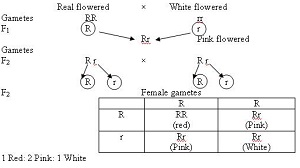CBSE Class 12 Principles of Inheritance and Variation class 12 Notes Biology in PDF are available for free download in myCBSEguide mobile app. The best app for CBSE students now provides Principles of Inheritance and Variation class 12 Notes latest chapter wise notes for quick preparation of CBSE board exams and school-based annual examinations. Class 12 Biology notes on chapter 5 Principles of Inheritance and Variation are also available for download in CBSE Guide website.
CBSE Guide Principles of Inheritance and Variation class 12 Notes Biology
CBSE guide notes are the comprehensive notes which covers the latest syllabus of CBSE and NCERT. It includes all the topics given in NCERT class 12 Biology textbook. Users can download CBSE guide quick revision notes from myCBSEguide mobile app and myCBSEguide website.
Class 12 Biology notes Chapter 5 Principles of Inheritance and Variation
Download CBSE class 12th revision notes for chapter 5 Principles of Inheritance and Variation in PDF format for free. Download revision notes for Principles of Inheritance and Variation class 12 Notes and score high in exams. These are the Principles of Inheritance and Variation class 12 Notes prepared by team of expert teachers. The revision notes help you revise the whole chapter 5 in minutes. Revision notes in exam days is one of the best tips recommended by teachers during exam days.
Download Revision Notes as PDF
CBSE Class 12 Biology Revision Notes Chapter 5 Principles of Inheritance and Variation
Genetics is the study of principles and mechanism of heredity and variation. Gregor Johann Mendel is known as ‘father of Genetics’.
- Inheritance is the process by which characters are passed on from parent to progeny. It is the basis of heredity.
- Variation is the degree by which progeny differ from their parents. Variation may be in terms of morphology, physiology, cytology and behavioristic traits of individual belonging to same species.
- Variation arise due to
- Reshuffling of gene/chromosomes.
- Crossing over or recombination
- Mutation and effect of environment.
Mendel’s Law of Inheritance: Mendel conducted hybridization experiments on garden pea (Pisum sativum) for seven years and proposed the law of inheritance in living organisms.
Selection of pea plant: The main reasons for adopting garden pea (Pisum sativum) for experiments by Mendel were –
- Pea has many distinct contrasting characters.
- Life span of pea plant is short.
- Flowers show self-pollination, reproductive whorls being enclosed by corolla.
- It is easy to artificially cross-pollinate the pea flowers. The hybrids thus produced were fertile.
Working method: Mendel’s success was also due to his meticulous planning and method of work –
- He studied only one character at a time.
- He used all available techniques to avoid cross-pollination by undesirable pollen grains.
- He applied mathematics and statistics to analyse the results obtained by him.
- Mendel selected 7 contrasting characters of garden pea for his hybridization experimentsContrasting Characters Studied by Mendel in Pea
Character Contrasting character (Dominant/Recessive) Stem height Tall/Dwarf Flower colour Violet/White Flower position Axial/Terminal Pod shape Inflated/Constricted Pod colour Green/Yellow Seed shape Round/wrinkled Seed colour Yellow/Green - Mendel conducted artificial hybridization/cross pollination using true breeding pea lines. True breeding lines are those that undergo continuous self-pollination and shows stable trait inheritance.
- Hybridization experiment includes emasculation (removal of anther) and transfer of pollen (pollination).
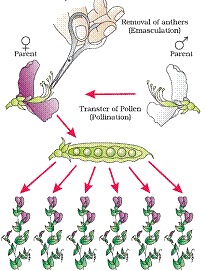
Inheritance of one gene (Monohybrid cross)
Mendel crossed tall and dwarf pea plant and collected all the seeds obtained from this cross. He grew all the seeds to generate plants of first hybrid generation called F1 generation. He observed that all the plants are tall. Similar observation was also found in other pair of traits.
Mendel self-pollinated the F1 plants and found that in F2 generation some plants are also dwarf. The proportion of dwarf plants is 1/4th and tall plants of 3/4th.
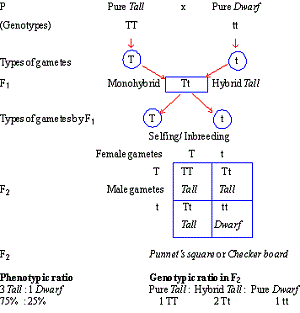
- Mendel called the ‘factors’ that passes through gametes from one generation to next generation. Now a day it is called as genes (unit of inheritance).
- Genes that code for a pair of contrasting traits are known as alleles.
- Alphabetical symbols are used to represent each gene, capital letter (TT) for gene expressed in F1 generation and small letter (tt) for other gene.
- Mendel also proposed that in true breeding tall and dwarf variety allelic pair of genes for height is homozygous (TT or tt). TT, Tt or tt are called genotype and tall and dwarf are called phenotype.
- The hybrids which contain alleles which express contrasting traits are called heterozygous (Tt).
- The monohybrid ratio of F2 hybrid is 3:1(phenotypic) and 1:2:1(genotypic).
Test cross is the cross between an individual with dominant trait and a recessive organism in order to know whether the dominant trait is homozygous or heterozygous.
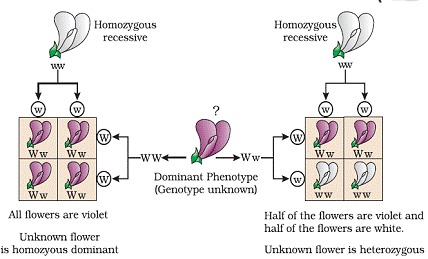
Principle or Law of Inheritance
Based on observations of monohybrid cross, Mendel proposed two law of inheritance-
1. Law of dominance– states that –
a. Characters are controlled by discrete units called factors.
b. Factors always occur in pair.
c. In a dissimilar pair of factors one member of pair dominate the other.
| Dominance | Recessive | |
| (i) | When a factor (allele) expresses itself in the presence or absence of its dominant factor called dominance. | It can only express itself in the absence of or its recessive factor allele. |
| (ii) | It forms a complete functional enzyme that perfectly express it. | It forms a incomplete defective enzyme which fails to express itself when present with its dominant allele, i.e., in heterozygous condition. |
2. Law of Segregation- alleles do not blends and both the characters are recovered during gametes formation as in F2 generation. During gametes formation traits segregate (separate) from each other and passes to different gametes. Homozygous produce similar kinds of gametes but heterozygous produce to different kinds of gametes with different traits.
Incomplete dominance
- It is a post Mendelian discovery. Incomplete dominance is the phenomenon of neither of the two alleles being dominant so that expression in the hybrid is a fine mixture or intermediate between the expressions of two alleles.
- In snapdragon (Mirabilis jalapa), there are two types of pure breeding plants, red flowered and white flowered. On crossing the two, F1 plants possess pink flowers. On selfing them, F2 generation has 1red: 2 pink: 1white. The pink flower is due to incomplete dominance.
Co-dominance
- It is the phenomenon of two alleles lacking dominance-recessive relationship and both expressing themselves in the organism.
- Human beings, ABO blood grouping are controlled by gene I. The gene has three alleles IA, IB and i. Any person contains any two of three allele IA, IB are dominant over i.
- The plasma membrane of the red blood cells has sugar polymers that protrude from its surface and the kind of sugar is controlled by the gene.
- When IA and IB are present together, both express their own types of sugars because of co-dominance.
| Incomplete Dominance | Co-Dominance | ||
| 1. | Effect of one of the two alleles is more conspicuous. | 1. | Effect of both the alleles are equally conspicuous. |
| 2. | It produces a mixture of the expression of two alleles. | 2. | There is no mixing of the effect of the two alleles. |
| 3. | The F1 does not resemble either of the parents. | 3. | The F1 resembles both the parents. |
| E.g.: Flower colour in dog flower. | E.g.: ABO blood grouping in humans, | ||
Multiple Alleles
They are multiple forms of a medelian factor or gene which occur on the same gene locus distributed in different organisms in the gene pool with an organism carrying only two alleles and a gamete only one allele. ABO blood grouping also provides a good example of multiple alleles.
Inheritance of Two genes (Dihybrid Cross)
A cross made to study simultaneous inheritance of two pairs of mendelian factors of genes.
Law of independent Assortment – The law states that ‘when two pairs of traits are combined in a hybrid, segregation of one pair of characters is independent of the other pair of characters’.In Dihybrid cross two new combinations, round green & wrinkled yellow are formed due to independent assortment of traits for seed shape i.e round, wrinkled and seed color i.e , yellow and green.
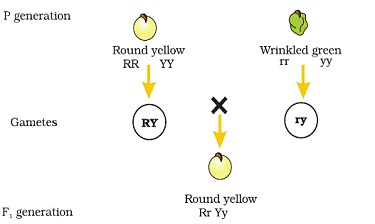
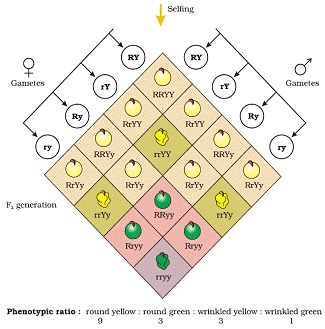
The ratio of 9:3:3:1 can be derived as a combination series of 3 yellow: 1 green, with 3 round : 1 wrinkled. This derivation can be written as follows: (3 Round : 1 Wrinkled) (3 Yellow : 1 Green) = 9 Round, Yellow : 3 Wrinkled, Yellow: 3 Round, Green : 1 Wrinkled, Green
Chromosomal Theory of Inheritance
- Chromosome as well as gene both occurs in pair. The two alleles of a gene pair are located on the same locus on homologous chromosomes.
- Sutton and Boveri argued that the pairing and separation of a pair of chromosomes would lead to segregation of a pair of factors (gene) they carried.
- Sutton united the knowledge of chromosomal segregation with mendelian principles and called it the chromosomal theory of inheritance.
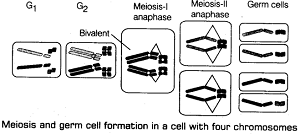
Linkage and Recombination
- When two genes in a Dihybrid cross were situated on same chromosome, the proportion of parental gene combination was much higher than the non-parental type. Morgan attributed this due to the physical association or the linkage of the two genes and coined the linkage to describe the physical association of genes on same chromosome.
- The generation of non-parental gene combination during Dihybrid cross is called recombination. When genes are located on same chromosome, they are tightly linked and show very low recombination.Difference between crossing over and linkage
Crossing over Linkage 1. It leads to separation of linked genes 1. keeps the genes together 2. It involves exchange of segments between non-sister chromatics of homologous chromosomes. 2. It involves individual chromosomes. 3. The frequency of crossing over can never exceed 50%. 3. The number of linkage group can never be more than haploid Chromosome number. 4. It increases variability by forming new gene combinations. 4. It reduces variability.
Sex Determination
- Henking in 1891 observed a trace of specific nuclear structure in few insects. He also observed that this specific nuclear structure is located on 50% of sperms only. He called this x body. He was not able to explain its significance.
- Latter it was observed that the ovum that receive the sperms with x body become female and those not becomes males, so this x body was called as sex chromosome and other chromosomes are called autosomes.
- In humans and other organisms XY types of sex determination is seen but in some insects like Drosophila XO type of sex determination is present.
- In both types of sex determination, male produce two different types of gametes either with or without X chromosome or some with X chromosome and some with Y chromosomes. Such types of sex determination are called male heterogamety.
- In birds ZW type of sex determination is present., two different types of gametes are produced by females in terms of sex chromosomes; this type of sex determination is called female heterogamety.
- Sex determination in human beings XY type. Out of 23 pairs of chromosomes, 22 pairs are exactly same in male and female called autosomes. A pair of X chromosome is present in female and XY in male. During spermatogenesis, male produce two type of gametes (sperms), 50% carries Y chromosome and remaining 50% contain X chromosome. Female, produce only one kind of gamete (ovum) having X chromosomes only.
- When sperm having Y chromosome the sex of baby is male and when sperm carrying X chromosome fertilse the egg, the sex of baby is female.

Mutationis a phenomenon which results in alternation of DNA sequence and consequently results in the change in the genotype and phenotype of an organism. The mutations that arise due to due to change in single base pair of DNA are called point mutation e.g Sickle cell anaemia.
Pedigree Analysis
- The analysis of traits in several of generation of a family is called the pedigree analysis. The inheritance of a particular trait is represented in family tree over several generations. It is used to trace the inheritance of particular trait, abnormality and disease.
Genetic Disorders
Broadly, genetic disorders may be grouped into two categories – Mendelian disorders and
Chromosomal disorders.
They are transmitted as the affected individual is sterile.This is always dominant in nature.
| Mendelian Disorders | Chromosomal disorders |
| These are due to alteration in a single gene. | These are caused due to absence or excess of one or more chromosomes or abnormal arrangement of one/more chromosomes. |
| They are transmitted into generations through Mendelian principles of inheritance. | They may be recessive or dominant in nature. |
| Examples: Colour blindness Pheffykenonia. | Examples: Downs syndrome, Turner’s syndrome |
Medelian disorder includes-
a. Haemophilia- sex linked recessive disease in which, in an infected individual, a minor cut leads to non-stop bleeding. Heterozygous female (carrier) can transmit the disease to their son. The possibility of a female becoming a haemophilic is extremely rare because mother of such a female has to be at least carrier and the father should be haemophilic (unviable in the later stage of life).
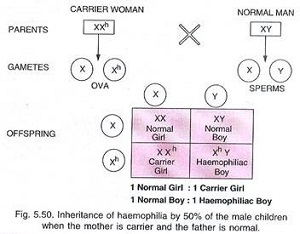
b. Sickle cell anemia- an autosome linked recessive trait in which mutant haemoglobin molecules undergo polymerization under low oxygen tension causing change in shape of the RBC from biconvex disc to elongated sickle like structure. The defect is caused by the substitution of Glutamic acid (Glu) by Valine (Val) at the sixth position of the beta globin chain of the haemoglobin molecule. The substitution of amino acid in the globin protein results due to the single base substitution at the sixth codon of the beta globin gene from GAG to GUG
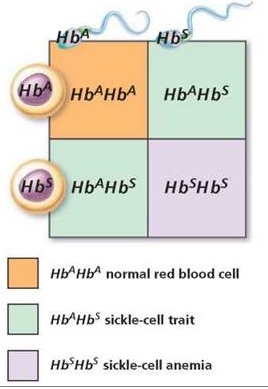
c. Phenylketonuria- inborn error of metabolism inherited as autosomal recessive trait. The affected individual lacks an enzyme that converts the amino acids phenylalanine to tyrosine . . As a result of this phenylalanine is accumulated and converted into phenylpyruvic acid and other derivatives that results into mental retardation.
Chromosomal Disorders-Failure of segregation of chromatids during cell division results in loss or gain of chromosome called aneuploidy. The failure of cytokinesis leads to two sets of chromosome called polyploidy.
a. Down’s Syndrome– is due to presence of additional copy of the chromosome number 21. The affected individual is short statured with small rounded head, furrowed tongue and partially opened mouth. Mental development is retarded.
b. Klinefleter’s Syndrome– due to presence of an additional copy of X-chromosome (XXY). Such persons have overall masculine development however, the feminine development (development of breast, i.e., Gynaecomastia) is also expressed. They are sterile.
c. Turner’s Syndrome– caused due to the absence of one of the X chromosome. 45 with XO, such females are sterile as ovaries are rudimentary. They lack secondary sexual characters.

CBSE Class-12 Revision Notes and Key Points
Principles of Inheritance and Variation class 12 Notes Biology. CBSE quick revision note for class-12 Chemistry Physics Math’s, Biology and other subject are very helpful to revise the whole syllabus during exam days. The revision notes covers all important formulas and concepts given in the chapter. Even if you wish to have an overview of a chapter, quick revision notes are here to do if for you. These notes will certainly save your time during stressful exam days.
- Physics
- Chemistry
- Mathematics
- Biology
- Accountancy
- Economics
- Business Studies
- Computer Science
- Informatics Practices
- English Core
- History
- Physical Education
To download Principles of Inheritance and Variation class 12 Notes Biology, sample paper for class 12 Physics, Chemistry, Biology, History, Political Science, Economics, Geography, Computer Science, Home Science, Accountancy, Business Studies and Home Science; do check myCBSEguide app or website. myCBSEguide provides sample papers with solution, test papers for chapter-wise practice, NCERT Principles of Inheritance and Variation, NCERT Exemplar Principles of Inheritance and Variation, quick revision notes for ready reference, CBSE guess papers and CBSE important question papers. Sample Paper all are made available through the best app for CBSE students and myCBSEguide website
- Reproduction in Organisms class 12 Notes Biology
- Sexual Reproduction in Flowering Plants class 12 Notes Biology
- Human Reproduction class 12 Notes Biology
- Reproductive Health class 12 Notes Biology
- Molecular Basis of Inheritance class 12 Notes Biology
- Evolution class 12 Notes Biology
- Human Health and Disease class 12 Notes Biology
- Strategies for Enhancement in Food Production class 12 Notes Biology
- Microbes in Human Welfare class 12 Notes Biology
- Biotechnology Principles and Processes class 12 Notes Biology
- Biotechnology and its Applications class 12 Notes Biology
- Organisms and Populations class 12 Notes Biology
- Ecosystem class 12 Notes Biology
- Biodiversity and Conservation class 12 Notes Biology
- Environmental Issues class 12 Notes Biology

Test Generator
Create question paper PDF and online tests with your own name & logo in minutes.
Create Now
Learn8 App
Practice unlimited questions for Entrance tests & government job exams at ₹99 only
Install Now